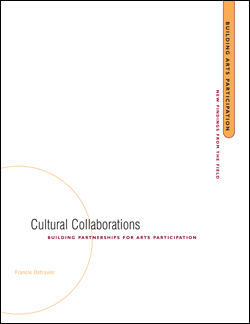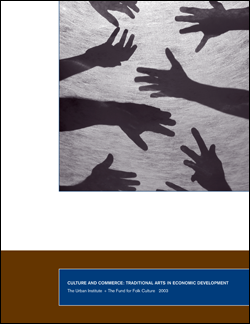Philanthropic practice
Two related sessions at grantmaking conferences last fall addressed important questions concerning the relationship of art, culture, and the environment. In each case, funders sought practical information about creative collaboration and successful cross-sector funding. Whether labeled "arts" or "environment" funders, grantmakers craved creative ways to attract new partners — both individuals and organizations — to their work.
Read More...January 2003, 46 pages. The Urban Institute, 2100 M Street, NW, Washington DC 20037, 202-833-7200, 202-429-0687 (fax), www.urban.org/publications/310616.html.
Download:
Read More...2003, 53 pages. Blueprint Research and Design, 415-677-9700 or 206-324-4999, www.blueprintrd.com; Social Venture Partners Seattle, 206-374-8757, www.svpseattle.org. Report available at www.svpseattle.org
Download:
Read More...2003, 52 pages. Fund for Folk Culture, P.O. Box 1566, Santa Fe, NM 87504-1566, 505-984-2534, www.folkculture.org; Urban Institute, 2100 M Street, N.W., Washington DC 20037, 202-833-7200, www.urban.org.
Download:
Read More...Editors of the Reader invited GIA's research advisors to reflect on challenges facing arts grantmakers in light of current research findings on arts funding trends.
What do recent research findings suggest about the prospect for the support of arts and culture in the years ahead?
Ed Pauly: After a decade of dramatic growth in foundations' support for the arts, the funding news is now somber. Yet the meaning we make from the most recent study of foundation funding for the arts depends, as always, on the perspective we choose.
Read More...Recently, several studies of arts funding have been conducted in specific cities and regions. We report on a few of these here. In the winter 2002 issue of the GIA Reader Vol. 13, No. 1, Lisa Cremin and Kathie de Nobriga reported on a comparative study of arts funding in Atlanta and nineteen other cities. The report was both an inspiring and a cautionary tale for Ann McQueen and others in Boston as they planned the study that Cindy Gehrig reviews below.
Read More...Booms and Busts
From the depths of our economic trough it is hard to look ahead, clear-eyed, and to see where U.S. foundations are headed. But consider, for a moment, where we have been. We have experienced an era in which: :
• New scientific and technological advances captured the popular imagination.
• These innovations promised a huge jump in economic productivity.
• There was talk about a new economy replacing an old economy.
• Many business corporations were consolidated and reorganized.
Arts Funding IV examines recent changes in arts grantmaking by one segment of private institutional donors — private and community foundations. While the larger, more fragmented arena of government and private support lies outside this investigation, it is nonetheless useful to place foundation support within this larger context. The following overview outlines the basic framework of private and public arts funding in the U.S. and discusses funding in relation to the overall financing of nonprofit arts groups.
Read More...At the GIA conference in fall, 2002, we hosted a round table discussion with the euphemistic title "Adapting in a Time of Constraints." Essentially its burden was to ask: what should we, as funders, be doing for the cultural institutions with whom we work in the context of these extraordinarily difficult times?
Read More...

